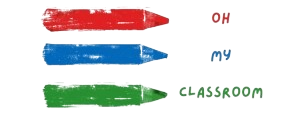Art is a magical gateway for young minds to express their creativity, explore their imaginations, and develop essential skills.
For kindergarteners, art projects serve as a colorful canvas that nurtures their cognitive, emotional, and physical growth.
We will embark on a colorful journey through Easy Art Projects for Kindergarten.
These projects are designed to captivate their attention, promote self-expression, and inspire a sense of accomplishment.
Bubble Wrap Printing:

Bubble wrap printing is a simple yet captivating art project that introduces kindergarteners to the world of texture and color. Start by covering a table with newspaper or a protective plastic sheet. Provide each child with a sheet of white paper, a variety of colorful paints, and a small piece of bubble wrap. Instruct them to dip the bubble wrap into the paint and then press it onto the paper, creating unique patterns and textures. The popping sound of the bubble wrap adds an element of excitement to the activity, making it even more enjoyable for the little artists. Once the prints are dry, encourage them to embellish their creations with additional drawings or stickers.
Nature Collage:

A nature collage is a wonderful way to combine outdoor exploration with art. Take the kindergarteners on a nature walk around the schoolyard or a nearby park, encouraging them to collect leaves, twigs, flowers, and other interesting natural materials. Back in the classroom, provide each child with a large sheet of paper and a glue stick. Let their imaginations run wild as they arrange and glue the collected items onto the paper, creating a vibrant collage that showcases the beauty of the outdoors. This activity not only allows children to appreciate nature but also enhances their fine motor skills as they handle delicate materials.
Related: 20 Exciting All About Me Preschool Activities
Paper Plate Masks:

Paper plate masks are a fantastic way to encourage imaginative play and self-expression in kindergarteners. Provide each child with a paper plate, scissors, and a variety of art supplies like markers, paints, feathers, and googly eyes. Instruct them to transform the paper plate into a unique mask by decorating it with colors, patterns, and other decorative elements. Encourage them to think about the character they want to portray and how they can express it through their mask. Once the masks are complete, organize a mini-mask parade, where each child can proudly show off their creation while pretending to be their chosen character.
Rainbow Salt Art:
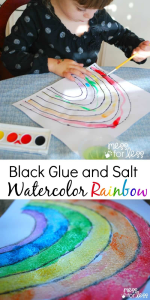
Rainbow salt art is a mesmerizing project that introduces kindergarteners to the concept of color blending and sensory exploration. Begin by providing each child with a sheet of black construction paper, a shallow tray, and small containers filled with salt dyed in different colors using food coloring or powdered paint. Instruct them to use their fingers or a spoon to sprinkle the colored salt onto the black paper, creating a vibrant and textured rainbow effect. As they work, they can observe how the colors mix and blend, creating new shades. This activity not only stimulates their creativity but also enhances their sensory development and fine motor skills.
Related: 15 Social and Emotional Activities for Preschoolers
Shape Collage:

Shape collage is a versatile and educational art project that allows kindergarteners to explore various shapes and their combinations. Provide each child with a variety of colored construction paper, safety scissors, and a glue stick. Instruct them to cut out different shapes, such as circles, squares, triangles, and rectangles, from the colored paper. They can then arrange and glue the shapes onto a larger sheet of paper, creating a unique and visually appealing collage. Encourage them to experiment with different arrangements, colors, and sizes, fostering their spatial awareness and understanding of basic geometry concepts.
Handprint Animals:

Handprint animals are a delightful way for kindergarteners to explore shapes and create adorable creatures. Provide each child with a blank piece of paper and non-toxic washable paints in various colors. Instruct them to dip their hands in the paint and press their handprints onto the paper. After the handprints have dried, encourage them to transform their handprints into animals by adding details with markers or crayons. They can turn a handprint into a lion, a fish, a butterfly, or any other animal that sparks their imagination. This activity not only promotes creativity but also develops their hand-eye coordination and fine motor skills.
Torn Paper Collage:

Torn paper collage is a tactile and engaging art project that allows kindergarteners to explore different textures and create unique compositions. Provide each child with a variety of colored construction paper, safety scissors, and glue sticks. Instruct them to tear the paper into different shapes and sizes, and then glue the torn pieces onto a larger sheet of paper. Encourage them to experiment with overlapping, layering, and arranging the torn paper to create interesting patterns and images. This activity fosters their fine motor skills, spatial awareness, and creativity.
Nature Printmaking:

Nature printmaking is a fascinating art project that combines the beauty of nature with the technique of printmaking. Take the kindergarteners on a nature walk to collect leaves, flowers, and other flat objects with interesting textures. Back in the classroom, provide each child with a piece of paper and washable tempera paints. Instruct them to dip their nature items into the paint and press them onto the paper, creating unique prints. Encourage them to explore different color combinations and experiment with overlapping prints. This activity not only introduces them to printmaking techniques but also allows them to appreciate the intricate patterns found in nature.
Yarn Painting:

Yarn painting is a hands-on and sensory-rich art project that sparks creativity and imagination. Provide each child with a sheet of paper, a variety of colorful yarns, and non-toxic washable paints. Instruct them to dip a length of yarn into the paint and then use it to create designs, patterns, or pictures on their paper. They can loop, twist, or swirl the yarn to add texture and movement to their artwork. This activity promotes fine motor skills, hand-eye coordination, and color exploration while allowing kindergarteners to express themselves through the medium of yarn.
Paper Tube Sculptures:

Paper tube sculptures offer a three-dimensional art experience for kindergarteners, encouraging them to think in terms of form and structure. Collect cardboard paper tubes of various sizes and provide each child with a variety of art supplies like markers, paint, and glue. Instruct them to cut, paint, and decorate the paper tubes as they wish. They can then arrange and connect the tubes to create sculptures, such as robots, animals, or abstract designs. This activity fosters their spatial reasoning, creativity, and problem-solving skills as they explore the possibilities of turning simple tubes into unique works of art.
Sponge Painting:
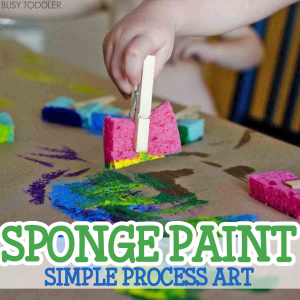
Sponge painting is a fun and mess-free art project that introduces kindergarteners to different textures and techniques. Provide each child with a variety of sponges cut into different shapes, non-toxic washable paints, and sheets of paper. Instruct them to dip the sponges into the paint and then press them onto the paper to create colorful patterns and designs. They can experiment with layering different sponge shapes and colors to create unique compositions. This activity not only stimulates their creativity but also enhances their fine motor skills and hand-eye coordination.
Paper Bag Puppets:

Paper bag puppets are a fantastic way for kindergarteners to combine art and storytelling. Provide each child with a paper lunch bag, markers, crayons, googly eyes, and other craft materials. Instruct them to decorate the paper bag to transform it into a character of their choice. They can draw faces, add colorful features, and use additional materials to bring their puppets to life. Once their puppets are complete, encourage them to use their creations to tell stories, perform puppet shows, or engage in imaginative play. This activity enhances their artistic skills, and storytelling abilities, and fosters creativity.
Dot Sticker Art:

Dot sticker art is a simple yet engaging art project that allows kindergarteners to create vibrant and visually appealing compositions. Provide each child with a sheet of paper and a variety of dot stickers in different colors. Instruct them to use the dot stickers to create patterns, shapes, or even larger images on their paper. They can experiment with color combinations, spacing, and placement to create their desired designs. This activity enhances their fine motor skills, and color recognition, and encourages them to explore patterns and repetition.
Recycled Material Sculptures:
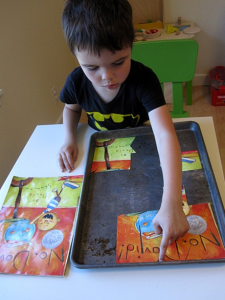
Recycled material sculptures provide kindergarteners with a unique opportunity to create art while promoting environmental awareness. Collect a variety of clean and safe recyclable materials such as cardboard tubes, bottle caps, plastic containers, and egg cartons. Provide each child with glue, scissors, and art supplies for decorating. Instruct them to use recycled materials to construct sculptures, animals, or abstract designs. Encourage them to think about form, balance, and how they can combine different materials to create their sculptures. This activity nurtures their creativity, and problem-solving skills, and promotes a sense of responsibility towards the environment.
Nature Weaving:
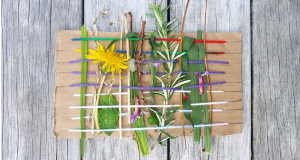
Nature weaving combines art and the natural world, encouraging kindergarteners to create beautiful and unique woven compositions using natural materials. Take the children on a nature walk to collect items such as small twigs, leaves, grass, and flowers. Back in the classroom, provide each child with a sturdy piece of cardboard or paper plate with evenly spaced slits along the edges. Instruct them to weave the collected natural materials through the slits, creating a woven pattern. They can experiment with different textures, colors, and arrangements to create visually interesting compositions. This activity promotes fine motor skills, creativity, and an appreciation for the beauty of nature.
Tissue Paper Collage:
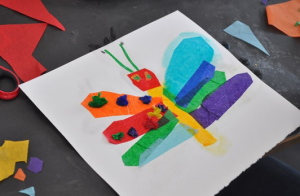
Tissue paper collage is a vibrant and versatile art project that allows kindergarteners to experiment with color mixing and create unique textured artwork. Provide each child with sheets of white paper, a variety of colorful tissue paper cut into small pieces and glue sticks. Instruct them to apply glue to the paper and then layer and arrange the tissue paper pieces on top, creating colorful collages. They can overlap the tissue paper to create new colors and textures. Encourage them to explore different patterns, shapes, and designs using tissue paper. This activity promotes fine motor skills, color recognition, and artistic expression.
Salt Dough Sculptures:
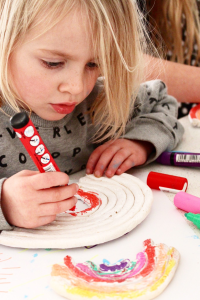
Salt dough sculptures provide a hands-on experience where kindergarteners can mold and shape their own creations. Help them make salt dough by mixing equal parts salt, flour, and water. Provide each child with a small ball of salt dough and instruct them to sculpt it into their desired shape using their hands or child-safe sculpting tools. Once they have created their sculptures, they can let them air dry or bake them according to the salt dough recipe instructions. Afterward, they can paint and decorate their dried sculptures with acrylic paints or markers. This activity fosters fine motor skills, sensory exploration, and imaginative play.
Shadow Tracing:
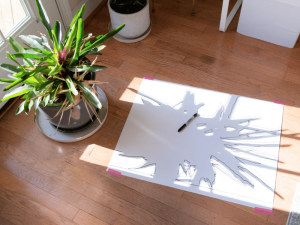
Shadow Tracing is a simple yet captivating art project that combines nature and creativity. Take the kindergarteners outside on a sunny day and provide them with large sheets of paper and drawing materials such as markers or crayons. Instruct them to place objects such as leaves, flowers, or toys on the paper to cast interesting shadows. They can then trace the outline of the shadows on the paper and fill in the traced shapes with colors or patterns. Encourage them to experiment with different objects and arrangements to create unique shadow artworks. This activity promotes observation skills, hand-eye coordination, and appreciation for light and shadows.
Stamped Art:
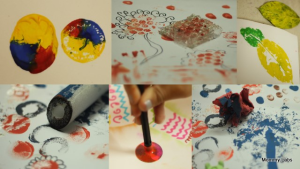
Stamped art is an exciting project that allows kindergarteners to explore different textures and patterns using stamps. Provide each child with a variety of stamping tools such as rubber stamps, foam shapes, or even household objects with interesting textures (e.g., sponge, bottle cap, cut vegetable). Pair the stamps with washable paints or stamp pads. Instruct them to dip the stamps into the paint or ink and press them onto paper, creating colorful patterns and designs. They can experiment with different combinations of stamps and colors to create unique artwork. This activity enhances fine motor skills, and creativity, and introduces the concept of repetition and patterns.
Vegetable Printing:
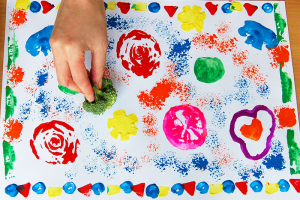
Vegetable printing is a delightful art project that introduces kindergarteners to the world of natural materials and textures. Provide each child with various vegetables cut in half (e.g., bell peppers, celery, carrots, apples) and washable paints. Instruct them to dip the cut side of the vegetables into the paint and press them onto the paper, creating interesting prints and patterns. They can experiment with different vegetable shapes, sizes, and colors to create unique compositions. Encourage them to observe the textures and patterns created by each vegetable. This activity fosters creativity, sensory exploration, and appreciation for the natural world.
